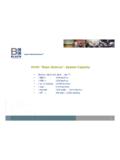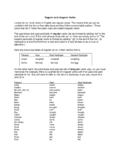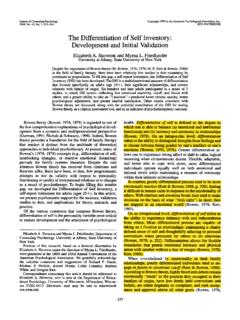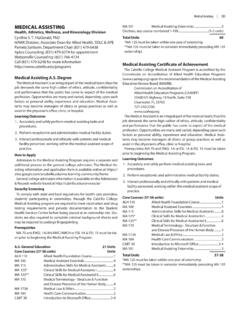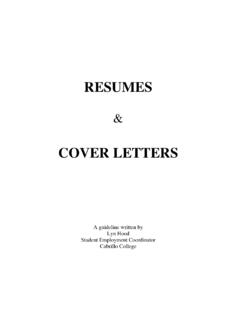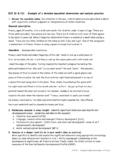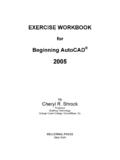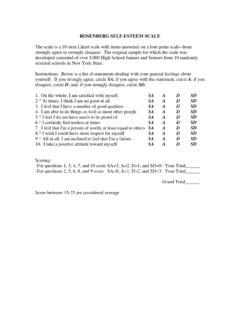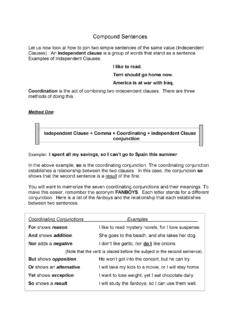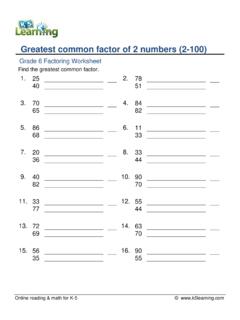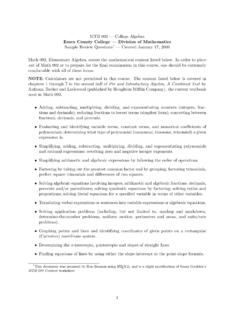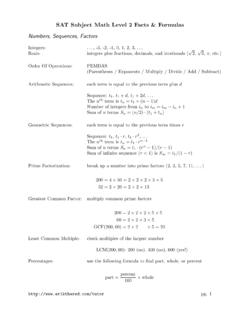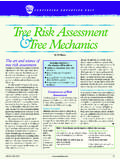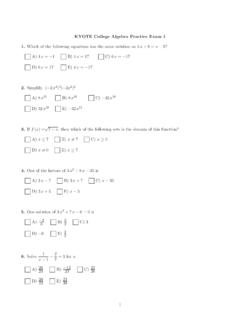Transcription of Beginning and Intermediate Algebra - Cabrillo College
1 Beginning and Intermediate AlgebraAn open source (CC-BY) textbookAvailable for free download at: #978-1-4583-7768-5 Copyright 2010, Some Rights Reserved and Intermediate Algebra by Tyler Wallace is licensed under a Creative CommonsAttribution Unported License. ( )Based on a work at are free: to Share: to copy, distribute and transmit the work to Remix: to adapt the workUnder the following conditions: Attribution: You must attribute the work in the manner specified by the author orlicensor (but not in any way that suggests that they endorse you or your use of thework).With the understanding that: Waiver: Any of the above conditions can be waived if you get permission from the copy-right holder.
2 Public Domain: Where the work or any of its elements is in the public domain underapplicable law, that status is in no way affected by the license. Other Rights: In no way are any of the following rights affected by the license: Your fair dealing or fair use rights, or other applicable copyright exceptions andlimitations; The author s moral rights; Rights other persons may have either in the work itself or in how the work is usedsuch as publicity or privacy rights Notice: For any reuse or distribution, you must make clear toothers the license term ofthis work. The best way to do this is with a link to the following web page: is a human readable summary of the full legal code which can be read at the followingURL: thanks to: My beautiful wife, Nicole Wallacewho spent countless hours typing problems andmy two wonderful kids for their patience andsupport during this projectAnother thanks goes to the faculty reviewers who reviewed this text: Donna Brown, MichelleSherwood, Ron Wallace, and Barbara WhitneyOne last thanks to the student reviewers of the text.
3 Eloisa Butler, Norma Cabanas, IreneChavez, Anna Dahlke, Kelly Diguilio, Camden Eckhart, Brad Evers, Lisa Garza, Nickie Hamp-shire, Melissa Hanson, Adriana Hernandez, Tiffany Isaacson, Maria Martinez, Brandon Platt,Tim Ries, Lorissa Smith, Nadine Svopa, Cayleen Trautman, and Erin White3 Table of ContentsChapter 0: Order of Properties of 1: Solving Linear One-Step Two-Step General Linear Solving with Absolute Value Application: Application: Application: 2: Points and Slope-Intercept Point-Slope Parallel & Perpendicular 3: Solve and Graph Compound Absolute Value 4: Systems of Three Application: Value Application: Mixture 5: Exponent Negative Scientific Introduction to Multiply Multiply Special Divide 6: Greatest Common Trinomials wherea= Trinomials wherea Factoring Special Factoring Solve by 7: Rational Reduce Rational Multiply and Least Common Add and Complex Solving Rational : Dimensional 8: Square Higher Adding Multiply and Divide Rationalize Rational Radicals of Mixed Complex 9: Solving with Solving with Complete the Quadratic Build Quadratics From Quadratic in Application: Application.
4 Simultaneous : Revenue and Graphs of 10: Function Operations on Inverse Exponential Logarithmic : Compound Trigonometric Trigonometric 0 : Integers .. Fractions .. Order of Operations .. Properties of Algebra .. - IntegersObjective: Add, Subtract, Multiply and Divide Positive ability to work comfortably with negative numbers is essential to success inalgebra. For this reason we will do a quick review of adding, subtracting, multi-plying and dividing of all the positive whole numbers, zero,and their opposites (negatives). As this is intended to be a review of integers, thedescriptions and examples will not be as detailed as a View Note:The first set of rules for working with negative numbers waswritten out by the Indian mathematician adding integers we have two cases to consider.
5 The first is if the signsmatch, both positive or both negative. If the signs match we will add the num-bers together and keep the sign. This is illustrated in the following examplesExample 1. 5 + ( 3)Same sign,add5 + 3,keep the negative 8 Our SolutionExample 2. 7 + ( 5)Same sign,add7 + 5,keep the negative 12 Our SolutionIf the signs don t match, one positive and one negative number, we will subtractthe numbers (as if they were all positive) and then use the sign from the largernumber. This means if the larger number is positive, the answer is positive. If thelarger number is negative, the answer is negative. This is shown in the 3. 7 + 2 Different signs,subtract7 2,use sign from bigger number,negative 5 Our SolutionExample 4.
6 4 + 6 Different signs,subtract6 4,use sign from bigger number,positive2 Our Solution7 Example + ( 3)Different signs,subtract4 3,use sign from bigger number,positive1 Our SolutionExample + ( 10)Different signs,subtract 10 7,use sign from bigger number,negative 3 Our SolutionFor subtraction of negatives we will change the problem to anaddition problemwhich we can then solve using the above methods. The way we change a subtrac-tion to an addition is to add the opposite of the number after the subtractionsign. Often this method is refered to as add the opposite. This is illustrated inthe following 3 Add the opposite of38 + ( 3)Different signs,subtract8 3,use sign from bigger number,positive5 Our SolutionExample 8.
7 4 6 Add the opposite of6 4 + ( 6)Same sign,add4 + 6,keep the negative 10 Our SolutionExample ( 4)Add the opposite of 49 + 4 Same sign,add9 + 4,keep the positive13 Our SolutionExample 10. 6 ( 2)Add the opposite of 2 6 + 2 Different sign,subtract6 2,use sign from bigger number,negative 4 Our Solution8 Multiplication and division of integers both work in a very similar pattern. Theshort description of the process is we multiply and divide like normal, if the signsmatch (both positive or both negative) the answer is positive. If the signs don tmatch (one positive and one negative) then the answer is negative. This is shownin the following examplesExample 11.
8 (4)( 6)Signs do not match,answer is negative 24 Our SolutionExample 12. 36 9 Signs match,answer is positive4 Our SolutionExample 13. 2( 6)Signs match,answer is positive12 Our SolutionExample 3 Signs do not match,answer is negative 5 Our SolutionA few things to be careful of when working with integers. First be sure not toconfuse a problem like 3 8with 3( 8). The second problem is a multipli-cation problem because there is nothing between the 3 and theparenthesis. Ifthere is no operation written in between the parts, then we assume that means weare multiplying. The 3 8problem, is subtraction because the subtraction sep-arates the 3 from what comes after it.
9 Another item to watch out for is to becareful not to mix up the pattern for adding and subtracting integers with thepattern for multiplying and dividing integers. They can look very similar, forexample if the signs match on addition, the we keep the negative, 3 + ( 7) = 10, but if the signs match on multiplication, the answer is positive,( 3)( 7) = Practice - IntegersEvaluate each )1 33)( 6) ( 8)5)( 3) 37)3 ( 5)9)( 7) ( 5)11)3 ( 1)13)6 315)( 5) + 317)2 319)( 8) ( 5)21)( 2) + ( 5)23)5 ( 6)25)( 6) + 327)4 729)( 7) + 72)4 ( 1)4)( 6) + 86)( 8) ( 3)8)7 710)( 4) + ( 1)12)( 1) + ( 6)14)( 8) + ( 1)16)( 1) 818)5 720)( 5) + 722)1 + ( 1)24)8 ( 1)26)( 3) + ( 1)28)7 330)( 3) + ( 5)Find each )(4)( 1)33) (10)( 8)35)( 4)( 2)37)( 7)(8)39)(9)( 4)41)( 5)(2)43)( 5)(4)32)(7)( 5)34)( 7)( 2)36)( 6)( 1)38)(6)( 1)40)
10 ( 9)( 7)42)( 2)( 2)44)( 3)( 9)1045)(4)( 6)Find each )30 1048) 12 450)30652)27354)80 856)50558)48860)54 647) 49 749) 2 151)201053) 35 555) 8 257) 16259)60 - FractionsObjective: Reduce, add, subtract, multiply, and divide with with fractions is a very important foundation to Algebra . Here we willbriefly review reducing, multiplying, dividing, adding, and subtracting this is a review, concepts will not be explained in detail as other lessons View Note:The earliest known use of fraction comes from the MiddleKingdom of Egypt around 2000 BC!We always like our final answers when working with fractions to be fractions is simply done by dividing both the numerator and denomi-nator by the same number.
